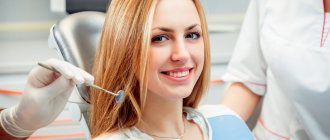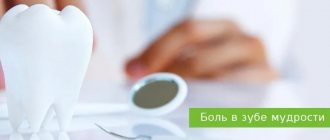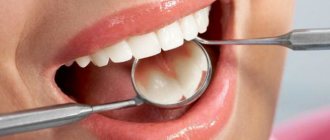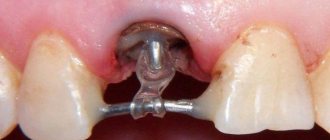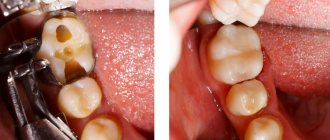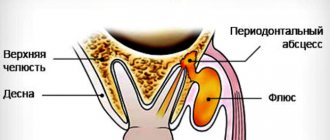Dangerous symptoms How to relieve pain?
Allowed painkillers When can teeth be treated? Is it possible to take an x-ray Prevention Toothache during pregnancy is a common occurrence. During this period, changes in the hormonal background of metabolism occur, and the woman’s body becomes very vulnerable. Pregnancy often serves as a catalyst for oral problems. Teeth begin to react to cold and hot. Painful sensations occur during hygienic cleaning, and gums may bleed. The acidity of saliva increases, the dentition is exposed to increased bacterial load.
There are more than enough reasons for toothache. Even with regular oral care and visits to the dentist, almost half of women during pregnancy experience caries, gingivitis, periodontitis, stomatitis and other inflammatory dental pathologies. If your tooth hurts during pregnancy, you should immediately go to the dentist.
Toothache cannot be tolerated, especially during pregnancy. Painful attacks negatively affect the functioning of the nervous and cardiovascular systems and can provoke involuntary contractions of the uterus and even premature birth. The opinion that it is undesirable to treat teeth during this period is a dangerous misconception. Even initial caries during pregnancy progresses much faster. Modern dentistry offers many effective means and treatment methods that are safe for the expectant mother and baby. The doctor selects treatment individually, according to the clinical picture and stage of pregnancy.
Content:
- Pregnancy and wisdom teeth - how to recognize the process of active growth
- Pericoronitis - complication 2.1. Classification of pathology
- What can an expectant mother do on her own?
- Removal
- What you should never do
- Competent treatment
- Rehabilitation after surgery
It happens that wisdom teeth begin to actively grow during pregnancy .
This is due to the fact that “eights” are cut later than other units. The process of their active growth can be triggered by hormonal and metabolic changes that occur in a woman’s body during pregnancy. The process of the appearance of eighth units in itself cannot be called negative - it is a variant of the norm. But for many expectant mothers it occurs with complications. It was also not uncommon for units to stand at the wrong angle and put extreme pressure on their “neighbors.” And this is an indication for emergency removal.
Are anesthesia and x-rays allowed during pregnancy?
Removing a wisdom tooth is a rather complicated and painful process. It is very difficult to endure it without pain relief and enormous stress, which can negatively affect the development of pregnancy. Therefore, of course, anesthetics are used. Previously, doctors used lidocaine, but it often causes allergic reactions. Today, dentistry uses safer analgesics that are not absorbed into the bloodstream and thus do not harm the baby.
Important! Individual intolerance must be taken into account, so a test is required.
Next, we will answer the other part of the question, which is relevant for all pregnant women going to the dentist - is it possible to do an x-ray. Doctors usually send their patients to take pictures to see the condition of the tooth. However, X-rays are contraindicated for pregnant women, since X-rays can harm the baby. In modern clinics, this study is performed using other equipment, for example, a radiovisiograph. This device does not dissipate the flow, but forms a narrow beam that acts locally. To protect the baby, an apron made of special material is put on the mother’s shoulders and stomach.
Important! Even with more modern devices, doctors try to prescribe examinations only in extreme cases.
Pregnancy and wisdom teeth - how to recognize the process of active growth
The symptoms that occur in pregnant women when the bone tissue above the figure eight “gives way” often differ from the classic picture. First, the woman notes that she began to get tired faster. Her performance decreases and her body temperature rises. In this case, the condition of the gums in the first days of symptoms may not change in any way.
Only after a few days (and sometimes weeks) it becomes clear that all the ailments are associated with teething. Signs characteristic of the situation are:
- pain when feeling the inflamed gum;
- acquisition of a red-blue hue by the mucous membranes located in the eruption zone;
- involuntary cheek twitching;
- enlarged and painful lymph nodes;
- the appearance of bad breath (it is not possible to get rid of it using standard hygiene products);
- hoarseness of voice;
- discomfort or throbbing pain in the ear on the causative side;
- painful sensations when chewing food, swallowing saliva, liquids.
If the first symptoms of the eruption of “eights” appear, it is important for the pregnant woman to calm down and not panic. It is quite possible that the emergence of new units will not be associated with any problems. But if the pain becomes severe, you should definitely get a dental consultation.
When is a wisdom tooth removed during pregnancy?
Since X-rays are contraindicated for pregnant women, the condition of the third molar is assessed using a radiovisiograph. The device gently irradiates the patient and converts the X-ray signal into a digital image.
If the “eight” grows vertically and there is enough space in the jaw for it, the dentist cuts the gum “hood” and facilitates eruption.
Removal during pregnancy is indicated when:
- It grows incorrectly;
- Compresses the roots of the adjacent molar;
- Provokes severe pain;
- Causes pulpitis and periostitis.
The period from 15 to 22 weeks is suitable for figure eight extraction. At this stage, the process of laying the fetal organs is completed, and the activity of the placenta is maximum - it does not allow the drugs that the dentist uses for pain relief and local treatment to pass through. In case of purulent inflammation, emergency surgery is performed in any trimester, because the infection can penetrate the placenta and affect the fetus.
In pregnant women, the dentist uses lidocaine, articaine and mepivacaine as anesthesia. The choice of drug depends on the timing and individual sensitivity of the patient. In order not to administer a large dose, to increase the time of pain relief and to prevent bleeding, the anesthetic is diluted with a vasoconstrictor. It is not advisable to use it at 1, 2 and 9 months of gestation, as it can cause uterine spasms, disrupt intestinal function and increase blood pressure.
Pericoronitis - a complication
Pericoronitis (pericoronitis) is a condition in which the soft tissues surrounding an erupting tooth become severely inflamed. Very often, this diagnosis is made to patients who have begun to see “figure eights” in their mouths. It is characterized by symptoms:
- sore gums;
- swelling;
- specific taste in the mouth.
For pericoronitis, surgery is most often indicated. During this procedure, the doctor excises the “hood” covering the unit to facilitate its eruption. Also, with this complication, there is sometimes a need for removal.
Classification of pathology
Pericoronitis is classified into:
- serous;
- purulent.
The disease always develops from the serous form. This is its initial stage. A large amount of serous fluid accumulates in the mucous tissues. Pain occurs when palpating the affected area.
If a woman does not go to the dentist on time, the serous form turns into a more dangerous one - purulent. Then the swelling becomes even stronger, and the body temperature periodically rises. A “hood” begins to cover the bone tissue, under which there is a large amount of pus.
The purulent form is treated exclusively surgically . After opening the “fistula,” the tissues are washed and the patient is prescribed antibiotics. Considering that such manipulations are extremely undesirable during the period of bearing a child, it is important not to start the disease and consult a doctor at the first sign of it.
What can an expectant mother do on her own?
Pregnant women should not self-medicate. But, if the eruption of wisdom teeth proceeds according to the classic scenario and does not cause negative symptoms, the woman can calm down. In this case, she does not need to run to the dentist.
To eliminate the occurrence of unpleasant sensations associated with putting pressure on the inflamed gum, you must try to chew food on the “healthy side”. After eating, be sure to rinse your mouth with warm water or a decoction of herbs. It is also permissible to purchase a special pharmacy rinse for this purpose.
If the pain intensifies, medical consultation is indicated. If for some reason it is impossible to get it right now, the expectant mother can take a no-shpa tablet to reduce the pain. But this should be a one-time “action”.
What to do after tooth extraction during pregnancy
Even if the procedure was successful, without pain, complications may develop during the recovery period. It is very important that after extirpation a blood clot is formed and firmly attached. It protects the resulting cavity with exposed bone and nerve endings from infection by bacteria and food.
The natural “plug” may come off in the following cases:
- sticking to a cotton swab (placed after surgery) if held for too long;
- licking the hole with the tongue;
- using a drinking straw;
- newly opened bleeding.
If the blood clot falls out, a new surgical intervention will be required. Otherwise, an inflammatory process will occur, which can lead to complications.
It is not recommended to get tired on the day of surgery. After the procedure, you need to go home and rest. You can eat after 3 - 4 hours. Food should be at a comfortable temperature, soft or liquid. Spicy, rough foods that injure soft tissues should be excluded. You should not smoke, as nicotine constricts blood vessels and interferes with healing.
You can rinse your mouth on the second day. As an antiseptic, pharmaceutical preparations, decoctions of medicinal plants, and an aqueous solution with salt and soda are used. Medicines will prevent the development of infection and speed up wound healing. Rinsing should be gentle and not intense, otherwise the blood clot will come off.
When brushing teeth, the surgical site is bypassed. You should use a toothbrush with soft bristles.
Until the wound heals, you should not overheat the body or exert physical stress. Otherwise, bleeding may resume.
Removal
As practice shows, only in 5% of cases pregnant women have to pull out the “eight”. In other situations, it is possible to do without deletion. Extraction is permissible only if there are strict indications, including:
- inability to relieve severe pain using available painkillers;
- frequent recurrence of pericoronitis;
- the formation of an abscess affecting the facial nerve;
- destruction and suppuration of bone tissue;
- the formation of a hollow tumor on the bone in the figure eight area.
In all these cases, the woman is scheduled for dental surgery. Anesthesia is selected taking into account the duration of pregnancy and existing concomitant diseases. However, earlier than in the second trimester, extraction is contraindicated.
What you should never do
A pregnant woman is strictly prohibited from doing the following things, as they can lead to malformations of the fetus:
- Take analgesics without a doctor's prescription. All drugs of this pharmacological group have many side effects.
- Apply painkillers to the inflamed gum. Such advice is available on the Internet, but you cannot follow it. Such compresses increase inflammation and create conditions for the formation of ulcers. In addition, the active compounds of the medications used will be absorbed into the systemic bloodstream and negatively affect the health of the fetus.
- Warm the affected area. Heat increases local blood circulation and helps the purulent tumor grow faster.
Self-medication during pregnancy is unacceptable. This is important for all women in an “interesting” position to understand.
How to relieve inflammation and numb the site of wisdom tooth eruption
The best way to relieve pain in the eight is to relieve inflammation. Traditional treatment for wisdom teeth during pregnancy turns out to be unavailable due to the interesting position of the expectant mother. Modern anti-inflammatory and painkillers are contraindicated for use during pregnancy and lactation, and removal of the figure eight, if possible, is only possible in the second trimester. To stop the inflammatory process and prevent the penetration of pathogenic microflora from the oral cavity into the gum tissue, rinsing will help. There are several recipes that are safe for pregnant women.
- Prepare a soda solution. To do this, dissolve half a teaspoon of baking soda and salt on the tip of a knife in a glass of warm water. Add 2-3 drops of iodine, and the rinse solution is ready. It is necessary to rinse with this solution up to 6 times during the day.
- Furacilin solution. Furacilin tablets have also proven themselves well as an antiseptic. They are not intended for oral use, only for external use. Dissolve 1 tablet per 100 ml of hot water (not boiling water). Rinse the area of inflammation with the prepared solution every three hours.
- Herbal infusions will also help if the wisdom tooth is swollen during pregnancy. Chamomile, calendula or sage are perfect for these purposes. These herbs have not only antiseptic but also anti-inflammatory properties. To prepare the infusion, use 1 tsp. selected raw materials per glass of water. Be sure to strain the infusion before using.
Furacilin solution, infusions of chamomile, sage and soda solution are safe recipes for rinsing the mouth during pregnancy.
A single rinse is unlikely to produce results. But if you carry out the procedure regularly, you will definitely be able to stop the inflammation without medications or surgery.
Important! During pregnancy, do not use antibiotic-based rinses. Of course, these agents most effectively destroy pathogenic bacteria and stop inflammation. But they also penetrate well into the blood, and through the placenta to the baby.
In addition to the fact that home rinses will help relieve inflammation, they can also reduce discomfort in the gum area. If the aching pain is quite intense, the following tips will help you cope with it:
- Soak a cotton swab in clove oil and place it on the teething site for 15 minutes.
- Cool the painful area. Regular ice will help you with this. Just before applying to the sore cheek, be sure to wrap the pieces of ice in a plastic bag and some kind of cloth so as not to cause frostbite to the skin.
- Squeeze out the garlic juice and soak a cotton swab in it. Apply it to the inflamed gum for 5-7 minutes.
These folk remedies are absolutely harmless for pregnant women, but they help cope with pain quite well. If the above method does not help, your erupting wisdom tooth during pregnancy will be advised by your gynecologist to relieve pain. Usually this is Nurofen or No-Spa. These drugs are not characterized by a negative effect on the child growing and developing inside you.
Attention! Under no circumstances should warm decoctions or heating be used for pain relief! This only aggravates the inflammatory process, contributing to the development of additional complications.
Competent treatment
Doctors can offer pregnant women only three options for eliminating inflammation during the eruption of wisdom teeth:
- Excision of the hood. The operation is simple and is performed under local anesthesia. The doctor makes a small incision, which reduces the likelihood of an abscess forming and speeds up the process of the “figure eight” appearance.
- Excision of the upper tissues of the mucous membrane. It is carried out if the doctor sees an abnormal bone structure in the image. The altered structures are then removed to save the tooth.
- Ripping out. It is used rarely and only if previous methods have proven ineffective. If extraction is unavoidable, it should be postponed until the threat to the health of the fetus is minimal.
Rehabilitation after surgery
If a woman was unable to avoid surgical treatment, she needs to pay maximum attention to the rehabilitation process. Recovery will be faster if the expectant mother:
- will follow all medical prescriptions;
- will provide complete rest to the damaged area (it should not be touched with hands, tongue, or foreign objects);
- will not eat solid foods;
- will carry out high-quality oral hygiene;
- He will come for a follow-up appointment when the dental surgeon says so.
Take care of the health of your smile. If you are planning to conceive, treat any existing oral diseases in advance. If the problem arose after conception, be sure to get dental care - do not risk your health and the health of your baby.
How to minimize the likelihood of deletion
Finally, let’s look at how preventive measures will help avoid an unpleasant procedure:
- regularly visit the dentist 1-2 times a year to solve problems in a timely manner;
- before planning a pregnancy, it is worth treating all teeth, removing damaged ones, filling those that can be restored;
- Monitor your diet throughout pregnancy. You should remove sweets from it as much as possible or try to brush your teeth after eating them;
- maintain careful hygiene;
- balance the diet to prevent deficiency of calcium and other microelements.
Finally, we note that prevention is in any case better than treatment, especially tooth extraction. Therefore, not only expectant mothers, but also those who are just planning a pregnancy, need to monitor the condition of the oral cavity and prevent the occurrence of serious problems that can negatively affect the health of both the woman herself and her baby.
